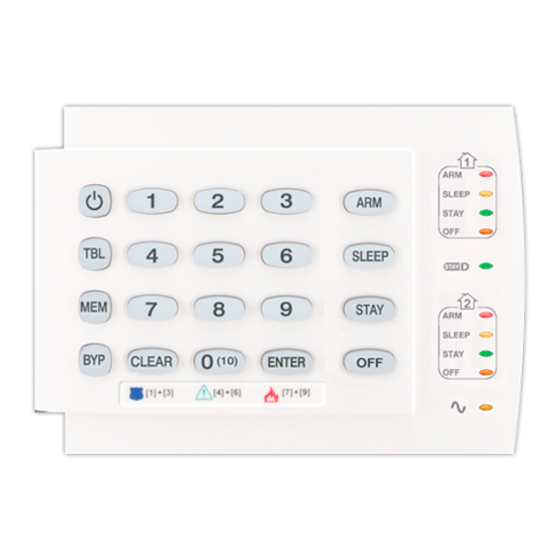
Table of Contents
Advertisement
Advertisement
Table of Contents

Summarization of Contents
Master Quick Menu Operations
User Programming
Guide to programming user access codes and settings.
System Delays Configuration
Setting entry, exit, and bell cutoff delays for system operation.
Time and Date Settings
Procedure for setting the system's current time and date.
WinLoad Communication Setup
Instructions for establishing communication with WinLoad software.
Communicator and System Functions
Communicator Setup
Configuring phone numbers and pager settings for communication.
Test Report Procedure
Sending a test report to the monitoring station.
Auto Arm Settings
Configuring automatic arming schedules for partitions.
Erase Lost Remote Controls
Procedure for removing lost or stolen remote controls.
System Options Configuration
Adjusting system behaviors like siren squawks and exit delays.
System Overview and Basic Operations
Auditory Feedback Explained
Understanding keypad beep tones for system feedback.
Visual Feedback: Keypad Lights
Interpreting keypad indicator lights for system status.
Magellan Series Keypad Overview
Description of keypad layout and indicator functions.
Keypad Features and Partitioning
MG32LED Keypad Details
Explanation of LEDs and indicators for MG32LED keypad.
MG32LRF Keypad Details
Explanation of LEDs, indicators, and Power/RX/TX for MG32LRF.
System Partitioning Explained
How to divide the alarm system into two distinct areas.
StayD Mode Operations
Activating and Deactivating StayD Mode
Steps to turn StayD mode on and off.
Changing Arming Levels (Stay/Sleep)
How to switch between Stay, Sleep, and Full arming modes.
Advanced StayD Settings
Opening zones without triggering alarms and re-arm delay.
Access Code Management
Access Code Types and Features
System Master Code, Master Codes, and Duress Code explained.
Programming New Access Codes
Step-by-step guide to programming user access codes.
Deleting Access Codes
Procedure for removing existing user access codes.
Arming and Disarming System
Regular Arming Procedure
How to arm all zones in a partition.
Sleep Arming Procedure
How to arm the perimeter and main floor zones.
Stay Arming Procedure
How to arm only perimeter zones, allowing movement inside.
One-Touch Arming and Fast Exit
One-Touch Regular Arming
Arming the system without an access code by holding the ARM key.
One-Touch Stay Arming
Arming perimeter zones without an access code by holding STAY.
One-Touch Sleep Arming
Arming zones without an access code by holding SLEEP.
One-Touch Bypass Programming
Accessing bypass programming mode by holding BYP.
Fast Exit Feature
Exiting premises while keeping the system armed.
Auto-Arming Configuration
Timed Auto Arming Setup
Programming automatic arming times for partitions.
No Movement Auto Arming
System arms based on lack of zone activity.
Disarming and Alarm Deactivation
System Disarming Procedure
How to disarm an armed system or an alarm.
Deactivating an Alarm
Steps to stop an active alarm.
Bypass Programming and Recall
Manual Bypass Programming
How to temporarily disable specific zones for arming.
Bypass Recall Feature
Reinstating previously saved bypass entries.
System Features and Alerts
Display Mode Options (MG32LRF)
Configuring keypad display to show all events or only alarms.
Alarm Display and Memory
How alarms are indicated and stored in memory.
Fire Alarm Procedures
Responding to fire alarms and accidental triggers.
Minimizing Fire Hazards and Safety Tips
Information on common fire causes and fire safety practices.
Panic Alarm Functions
Using panic alarms for police, medical, or fire emergencies.
Chime Zone Programming
Chiming Zones on MG32LED Keypads
Enabling chime alerts for specific zones on MG32LED keypads.
Chiming Zones on MG10LEDV/H Keypads
Enabling chime alerts for specific zones on MG10LEDV/H keypads.
Keypad Muting and Backlight
Keypad Muting Feature
Disabling keypad beeps for alarms and chime zones.
Adjusting Keypad Backlight
Modifying the brightness level of keypad keys.
PGM Keys (Programmable Outputs)
PGM Functionality and Activation
Using PGM outputs for various system events and controls.
Power Save Mode
Power Save Mode Operation (MG32LRF)
Keypad display shuts off during power loss to save energy.
Trouble Display and Clock Reprogramming
Accessing System Trouble Display
Identifying and understanding various trouble conditions.
Trouble List Explanations
Descriptions of common trouble conditions like low battery or communication.
Reprogramming System Clock
Procedure for resetting the system's internal clock due to timer loss.
Advanced Features and Functions
Quick Function Keys Usage
Using special key combinations for reports and calls.
System Testing and Maintenance
Guidelines for testing system components and battery replacement.
System Configuration Summary
Zone Description and Partitioning
Defining zones and system partitioning settings.
Panic Alarms and PGM Configuration
Setting up panic alarm types and PGM assignments.
System Timers Settings
Configuring exit and entry delay timers for partitions.
Special Keys and Features Overview
Summary of one-touch arming features.
















Need help?
Do you have a question about the MG10LEDV and is the answer not in the manual?
Questions and answers